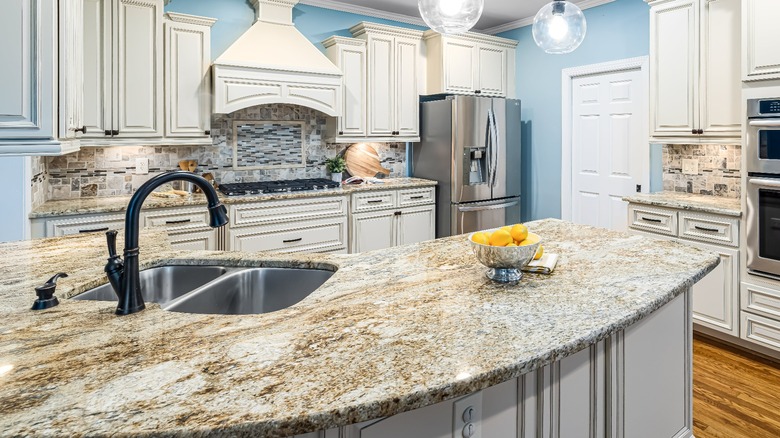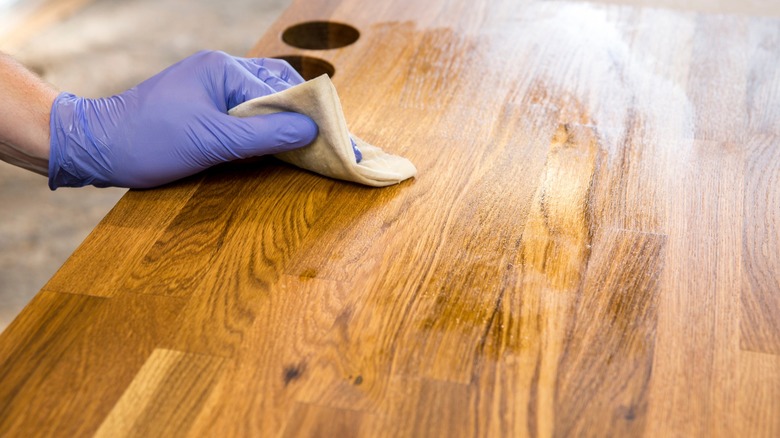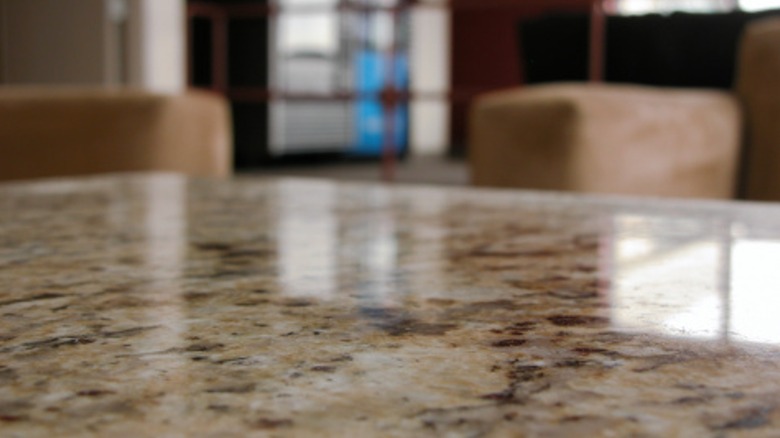How To Get The Look Of Granite Countertops For Way Less
Whether it's in your kitchen or your bathroom, installing granite countertops is a big endeavor, and folks often end up putting up with poor substitutions. If you're the unfortunate situation of being trapped with ugly countertops, don't give up just yet. There's a cheaper way to change your countertops — paint them. By using a few simple-to-master painting techniques, you can give your bland countertop a luxurious, granite-inspired finish. Painting countertops might sound like a recipe for DIY disaster, but with the appropriate material and the proper supplies, you can successfully revamp your tired countertops.
If this DIY idea catches your eye, then your first step is to investigate whether your countertop is the right candidate for the project. Laminate, wood, and concrete countertops are the simplest to paint over, but it's possible to paint stone countertops, as well. That said, be cautious about painting over real stone or tile — not only is it tricky, but you could be reducing the value of quality materials. For your painting supplies, you'll need sanding paper, primer, paint, paintbrushes, sponges, and tape. When in doubt about what tools or paints to use, consult a professional at your local home improvement store.
How to paint countertops
Before you do anything to your countertops, give them a good, thorough cleaning. Any dirt dried onto your countertops will get sealed underneath layers of primer and paint, so now is your chance to scrub down the counter and ensure you have a smooth, clean surface. Next, sand the countertop so that paint can adhere to it more easily. After your countertops are prepped, start laying out your painter's tape. Put it anywhere you don't want to get paint — this is typically the edges where the counter meets walls, cabinets, or sinks, as well as the edges near appliances like stoves.
For a professional finish, it's recommended to apply a coat of primer. While it's okay in some DIY projects to cheat a little and skip the primer step, countertops can be a funky material to paint, and you'll really need that priming layer to properly prepare the surface. For laminate countertops, a standard water-based acrylic primer and paint should work just fine, but if you have a stone countertop, you should look into epoxy primers and paints. Now you can paint the countertops. The method involves using several colors and a mix of sponges and brushes recreate the appearance of granite.
Recreating the granite look
To get a look that evokes granite, you're going to need to exercise a little technical skill. You can buy kits with all the supplies and instructions you need, but if you're motivated, it's completely possible to do it on your own. To begin with, forgo the paint roller and standard paintbrush in favor of sponges and small detailing brushes. The key is to have a textured, marbled look, rather than big brushstrokes. You can get inspiration by searching online for images of granite and studying the natural patterns you like best.
The first step is to sponge on paint of different colors. For your colors, look for earthy tones of varying shades. Include both dark and light natural tones so you can have contrast in the pattern. Aim for at least three base colors for your faux granite, and use the sponge to apply random dots of the colors across your countertops. The technique is similar to sponge painting your wall – create the pattern by gently pressing the sponge onto the surface. As you layer more of these multicolored sponge imprints, you will start to get an approximation of the speckled pattern of real granite. For some extra flair, use a slightly shiny highlight color and sparingly apply small, random veining to the countertop, to create that sparkly mineral effect. Once done, seal the paint with a protective topcoat.


